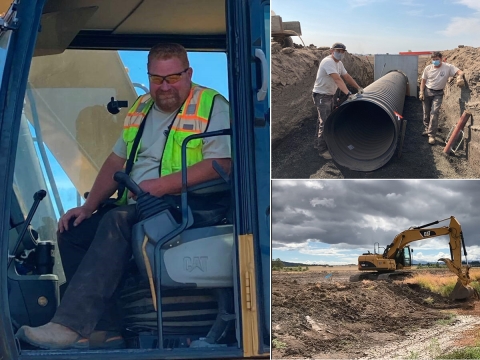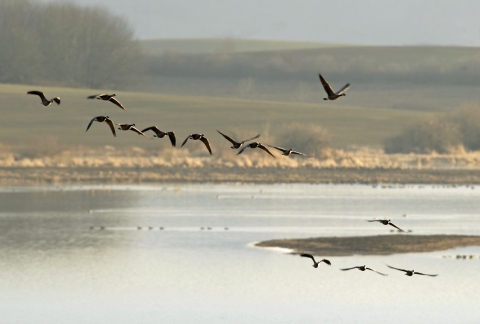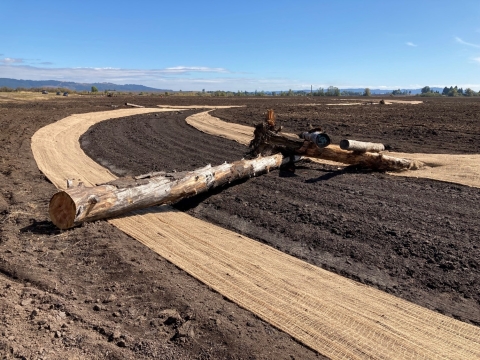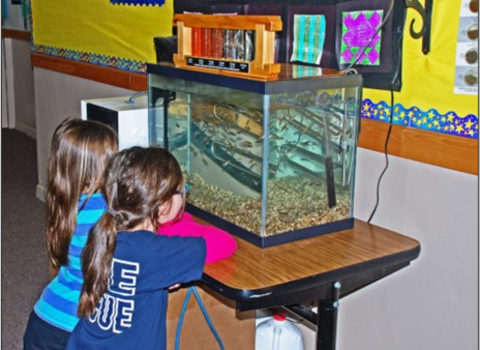Robert Little has always been passionate about the outdoors. Raised on a farm in southern Washington, he learned the importance of protecting natural resources and the joy of appreciating their basic value from a young age. It was only natural then for Robert to join the Service, which he did in 1984 as a heavy equipment operator. He spent the next 36 years working to manage habitats and protect wildlife at national fish hatcheries and national wildlife refuges.
Robert’s love for the outdoors led him to Baskett Slough National Wildlife Refuge. Established in 1965, the 2,500-acre refuge is an oasis for waterfowl in Oregon’s Willamette Valley. Refuge staff cultivates habitat for the many species of birds that travel along the Pacific Flyway, stopping at the refuge to feed and rest.
Previously used for agriculture, the refuge lands had been drained to grow crops, causing the loss of natural wetlands.
To convert wetlands to dry fields, past landowners had straightened and channelized the Baskett Slough Creek, which travels through the refuge. These channels helped siphon water from the landscape to create land for agricultural production.
In 1997, Robert joined a team of maintenance workers and heavy equipment operators to restore the Dusky Marsh at Baskett Slough. The goal of the Dusky Marsh restoration project was to provide seasonal wetland habitat for migrating birds such as dusky Canada geese. Creating more habitat would give these birds room to feed and encourage them to stay on protected refuge lands rather than on neighboring farms where they can damage crops.
To build a wetland, the refuge needed to be able to collect water. This is where Robert and his team came in. They installed two water control structures within the channelized waterway and built a 3,000-foot earthen dam to hold water. As rainfall runoff traveled down the stream, the structures would allow the refuge staff to dam certain areas and create the desired wetland habitat. The project was a success and soon the restored Dusky Marsh was attracting wintering waterfowl and supporting thousands of Canada geese, cackling geese, and dabbling ducks.
When they were built, the dam and water control structures were standard for wetland restoration. Over time, however, biologists started to think more holistically about habitat restoration projects and consider fish passage fish passage
Fish passage is the ability of fish or other aquatic species to move freely throughout their life to find food, reproduce, and complete their natural migration cycles. Millions of barriers to fish passage across the country are fragmenting habitat and leading to species declines. The U.S. Fish and Wildlife Service's National Fish Passage Program is working to reconnect watersheds to benefit both wildlife and people.
Learn more about fish passage barriers in flood plains and their effects on an ecosystem.
Native fish require unobstructed waterways to travel upstream and spawn each year, and a lack of navigable streams is a major reason for fish declines in the Pacific Northwest. After surveying the Baskett Slough Creek, biologists found that same water control structures that helped to create the Dusky Marsh did not allow fish to easily travel up or down-stream. This information prompted a rethinking of how to manage the wetland while also improving fish passage.
In 2017, the refuge began working with the Oregon Department of Fish and Wildlife to fix the problem. The easiest and least expensive solution would have been to add fish ladders to the water control structures. These ladders allow fish traveling upstream to “climb” above barriers and continue their way. While these ladders are effective, they do not solve the problem of unobstructed fish movement and some fish still can’t reach their desired locations.
The refuge decided to remove the structures entirely with the goal of returning the creek to its original condition. The unnaturally high straight sides of the Dusky Marsh agricultural channels not only prevented seasonal wetland flooding but also made poor wildlife habitat for aquatic species.
Fish need undulating banks and structures such as fallen trees to hide from predators and forage for food. The plan was to re-establish a curving stream and add natural debris to protect migrating wildlife.
Removing the water control structures would, however, limit the refuge’s ability to collect water and maintain the restored wetlands. To solve this problem, the team decided to create a new setback earthen dam that would run parallel to the creek, behind which water could pool for wildlife habitat. The stream in its newly designed stream channel would also provide seasonal wetlands as water would be able to flood its low banks during heavy rain events before eventually traveling downstream and emptying into the Willamette River.
In the Willamette Valley of Oregon, heavy winter and spring rainfall means that this kind of large-scale project must be completed during the short, sunny summer months. Construction would take eight weeks and would require over a dozen skilled maintenance specialists and heavy equipment operators to move over 30,000 cubic yards of earth and remove two water control structures. To obtain the necessary permits, the refuge would need to collaborate with environmental engineers and map out how to make this restoration a reality without compromising waterfowl habitat or jeopardizing neighboring farmers’ lands. These investments can be costly.
Thanks to the passage of the Great American Outdoors Act Great American Outdoors Act
This landmark conservation law, enacted in 2020, authorizes the use of up to $1.9 billion a year in energy development revenues for five years for needed maintenance to facilities and infrastructure in our wildlife refuges, national parks, forests, recreation areas and American Indian schools.
Learn more about Great American Outdoors Act in 2020, we have access to funding to invest in habitat improvement projects that also expand recreational access for the American public.
With the newly available funds, the Service formed Maintenance Action Teams (MAT) of veteran workers and newer employees. These teams travel to refuges across the country and tackle deferred maintenance projects and challenging habitat restoration, such as the Dusky Marsh one.
Workers from all over the country make up the teams, and they bring a diverse set of skills with them. These projects are not only essential for habitat restoration but allow the seasoned workers to mentor newer employees, helping them to learn new skills and obtain necessary certifications on different types of machinery so they can continue to restore habitats for years to come.
MAT projects also save the Service over 30% in costs on each project over traditional contracting costs.
When Robert Little, who had left Baskett Slough in 2001 and continued working at refuges and hatcheries across the West, heard about the Dusky Marsh restoration plans, he eagerly agreed to join the MAT. Then he headed back to one of his first projects to participate in the upgrade.
In August 2021, the first team broke ground with Robert and engineering equipment operator Jeremy DePiero leading the charge. After 36 years with the agency, the Dusky Marsh renovation project would be one of Robert’s last before retirement.
“One thing I love about the U.S. Fish and Wildlife Service,” Robert says, “is that when we have new scientific information or when we learn a better way of doing something, we work to upgrade our best management practices. When we installed the water control structures in 1999, that was the best way to create a wetland on the refuge. With new information, we are now upgrading the design to allow for ›› better fish passage and to improve habitat for native fish while still helping waterfowl.”
Throughout August and September, the teams worked long hours and endured record heat to ensure the project was completed before the fall rains began.
To meet their schedule, teams of seven labored over 70 hours a week to get all the work done.
By late September, they had restored nearly a mile of Basket Slough Creek, removed an old dam on the eastern boundary of the property that blocked water flow, and created a new setback dam parallel to the creek to ensure the wetlands persisted. The 98-acre restoration project not only improves fish passage and provides habitat for waterfowl, but it also supports federally protected species such as Nelson’s checkermallow, the Willamette daisy, and the streaked horned lark that will use the restored wet prairie habitat within the project’s footprint.
These kinds of projects need talented and hard-working staff who battle the elements, overcome equipment challenges, and move mountains to get the job done.
“Coming back here to work on this project at the end of my career feels like I’ve come full circle,” Robert says. “This is the best way to celebrate my retirement, and I will head into the next chapter knowing that I helped make this habitat better for the plants and animals that I love.”







